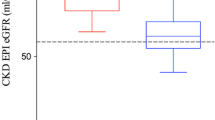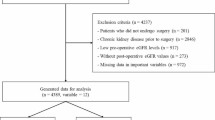Abstract
Purpose
To provide a new model to predict long-term renal function impairment after partial nephrectomy (PN).
Methods
Data of consecutive patients who underwent minimally invasive PN from 2005 to 2022 were analyzed. A minimum of 12 months of follow-up was required. We relied on a machine-learning algorithm, namely classification and regression tree (CART), to identify the predictors and associated clusters of chronic kidney disease (CKD) stage migration during follow-up.
Results
568 patients underwent minimally invasive PN at our center. A total of 381 patients met our inclusion criteria. The median follow-up was 69 (IQR 38–99) months. A total of 103 (27%) patients experienced CKD stage migration at last follow-up. Progression of CKD stage after surgery, ACCI and baseline CKD stage were selected as the most informative risk factors to predict CKD progression, leading to the creation of four clusters. The progression of CKD stage rates for cluster #1 (no progression of CKD stage after surgery, baseline CKD stage 1–2, ACCI 1–4), #2 (no progression of CKD stage after surgery, baseline CKD stage 1–2, ACCI ≥ 5), #3 (no progression of CKD stage after surgery and baseline CKD stage 3–4–5) and #4 (progression of CKD stage after surgery) were 6.9%, 28.2%, 37.1%, and 69.6%, respectively. The c-index of the model was 0.75.
Conclusion
We developed a new model to predict long-term renal function impairment after PN where the perioperative loss of renal function plays a pivotal role to predict lack of functional recovery. This model could help identify patients in whom functional follow-up should be intensified to minimize possible worsening factors of renal function.

Similar content being viewed by others
Data availability
Data are available on specific request.
References
Ljungberg B, Albiges L, Abu-Ghanem Y et al (2022) European Association of Urology Guidelines on renal cell carcinoma: the 2022 update. Eur Urol 82(4):399–410. https://doi.org/10.1016/j.eururo.2022.03.006
Van Poppel H, Da Pozzo L, Albrecht W et al (2011) A prospective, randomised EORTC intergroup phase 3 study comparing the oncologic outcome of elective nephron-sparing surgery and radical nephrectomy for low-stage renal cell carcinoma. Eur Urol 59(4):543–552. https://doi.org/10.1016/j.eururo.2010.12.013. (Epub 2010 Dec 22)
MacLennan S, Imamura M, Lapitan MC, UCAN Systematic Review Reference Group; EAU Renal Cancer Guideline Panel et al (2012) Systematic review of perioperative and quality-of-life outcomes following surgical management of localised renal cancer. Eur Urol 62(6):1097–1117
Kates M, Badalato GM, Pitman M, McKiernan JM (2011) Increased risk of overall and cardiovascular mortality after radical nephrectomy for renal cell carcinoma 2 cm or less. J Urol 186(4):1247–1253. https://doi.org/10.1016/j.juro.2011.05.054. (Epub 2011 Aug 17)
Go AS, Chertow GM, Fan D, McCulloch CE, Hsu CY (2004) Chronic kidney disease and the risks of death, cardiovascular events, and hospitalization. N Engl J Med 351:1296–1305
Huang WC, Levey AS, Serio AM et al (2006) Chronic kidney disease after nephrectomy in patients with renal cortical tumours: a retrospective cohort study. Lancet Oncol 7(9):735–740
Volpe A, Blute ML, Ficarra V et al (2015) Renal ischemia and function after partial nephrectomy: a collaborative review of the literature. Eur Urol 68(1):61–74
Yu YD, Nguyen NH, Ryu HY et al (2019) Predictors of renal function after open and robot-assisted partial nephrectomy: a propensity score-matched study. Int J Urol 26(3):377–384
Bhindi B, Lohse CM, Schulte PJ et al (2019) Predicting renal function outcomes after partial and radical nephrectomy. Eur Urol 75(5):766–772
Levey AS, Stevens LA, Schmid CH et al (2009) A new equation to estimate glomerular filtration rate. Ann Intern Med 150:604–612
Bellomo R, Ronco C, Kellum JA, Mehta RL, Palevsky P, Acute Dialysis Quality Initiative Workgroup (2004) Acute renal failure—definition, outcome measures, animal models, fluid therapy and information technology needs: the Second International Consensus Conference of the Acute Dialysis Quality Initiative (ADQI) Group. Crit Care 8:R204–R212
Levin A, Stevens PE, Bilous RW, Kidney disease: Improving global outcomes (KDIGO) CKD work group et al (2013) KDIGO 2012 clinical practice guideline for the evaluation and management of chronic kidney disease. Kidney International Supplements. 3(1):1–150
Breiman L, Friedman J, Olshen R, Stone Breiman C (1984) Classification and regression trees. Chapman and Hall, Wadsworth
Xiong L, Nguyen JK, Peng Y et al (2022) What happens to the preserved renal parenchyma after clamped partial nephrectomy? Eur Urol 81(5):492–500
Bravi CA, Vertosick E, Benfante N et al (2019) Impact of acute kidney injury and its duration on long-term renal function after partial nephrectomy. Eur Urol 76(3):398–403
Martini A, Cumarasamy S, Beksac AT et al (2018) A nomogram to predict significant estimated glomerular filtration rate reduction after robotic partial nephrectomy. Eur Urol 74(6):833–839
Mari A, Tellini R, Antonelli A et al (2022) A nomogram for the prediction of intermediate significant renal function loss after robot-assisted partial nephrectomy for localized renal tumors: a prospective multicenter observational study (RECORd2 Project). Eur Urol Focus 8(4):980–987
Pecoraro A, Campi R, Bertolo R, et al (2023) Estimating postoperative renal function after surgery for nonmetastatic renal masses: a systematic review of available prediction models. Eur Urol Oncol. S2588-9311(22)00205-X
Funding
None.
Author information
Authors and Affiliations
Contributions
AU data analysis, data collection, manuscript writing/editing. MB data analysis, manuscript writing/editing. AG manuscript editing. AT manuscript writing/editing. JMG manuscript writing/editing. IS data management. JR data collection. MC data management. PD data collection. PV data collection. GB data collection. OR-F data management. AR data management. JP protocol/project development. AB protocol/project development, manuscript editing.
Corresponding author
Ethics declarations
Conflict of interest
The authors have nothing to disclose.
Research involving human participants and/or animals
All analysis performed involving human participants were in accordance with the 1964 Helsinki Declaration and its later amendments.
Consent to participate
All patients signed an informed consent agreeing to supply their anonymous information for research purposes.
Additional information
Publisher's Note
Springer Nature remains neutral with regard to jurisdictional claims in published maps and institutional affiliations.
Supplementary Information
Below is the link to the electronic supplementary material.
Rights and permissions
Springer Nature or its licensor (e.g. a society or other partner) holds exclusive rights to this article under a publishing agreement with the author(s) or other rightsholder(s); author self-archiving of the accepted manuscript version of this article is solely governed by the terms of such publishing agreement and applicable law.
About this article
Cite this article
Uleri, A., Baboudjian, M., Gallioli, A. et al. A new machine-learning model to predict long-term renal function impairment after minimally invasive partial nephrectomy: the Fundació Puigvert predictive model. World J Urol 41, 2985–2990 (2023). https://doi.org/10.1007/s00345-023-04593-8
Received:
Accepted:
Published:
Issue Date:
DOI: https://doi.org/10.1007/s00345-023-04593-8




